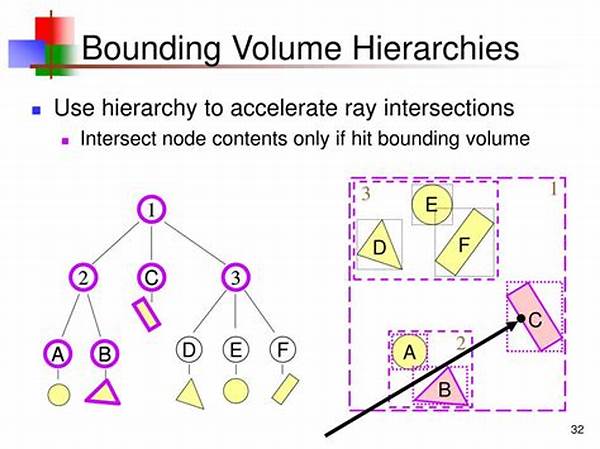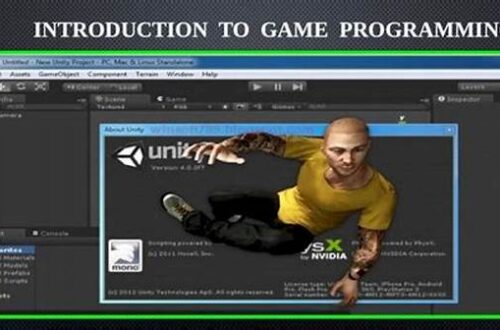Hey there, fellow tech enthusiasts! Let’s delve into the world of Bounding Volume Hierarchy (BVH) techniques. If you’ve ever found yourself lost in the dense jungle of 3D computer graphics or wondered how your favorite video games render so smoothly, then grab your virtual hiking boots, because we’re about to explore this fascinating territory together. So, what’s the deal with BVH? Why is it all the rage with graphic designers and developers alike? Allow me to give you the lowdown in the most casual, blogger-friendly style possible. Ready? Let’s get started!
Read Now : Geometric Transformation Process Optimization
Understanding Bounding Volume Hierarchy Techniques
Bounding volume hierarchy techniques are essentially the unsung heroes behind efficient rendering and collision detection in 3D environments. Imagine trying to animate a complex scene with numerous objects; it’s like herding cats, right? BVH comes to the rescue by organizing objects into a hierarchy of bounding volumes, making calculations more manageable and processing faster.
Implemented in numerous graphics engines, bounding volume hierarchy techniques help to quickly eliminate objects not relevant to a particular computation, like which objects are in the camera’s view or which might collide with each other. This efficiency lets graphics professionals create rich, interactive experiences without overwhelming computational resources. It’s like having a sorting hat that knows how to save the day in any chaotic magical world.
The real magic lies in how BVH reduces the number of collision checks needed during rendering by organizing the scene into a tree structure. Each node in this tree is a bounding volume that encompasses child objects or other bounding volumes. Think of it as a parent constantly watching over its boisterous children, ensuring everyone stays in line and plays nice, all while keeping the family logbook up-to-date!
Practical Applications of Bounding Volume Hierarchy Techniques
1. Imagine a busy 3D world in a game. Bounding volume hierarchy techniques help streamline which objects need rendering at any given moment, saving valuable processing power and letting players immerse themselves in the experience.
2. VFX artists adore bounding volume hierarchy techniques because they allow for realistic and complex animations without slowing down the entire visual process, making blockbuster movies come alive.
3. CAD software leverages bounding volume hierarchy techniques to efficiently manage complex models, ensuring that simulations or renderings are done smoothly without unnecessary delays.
4. Augmented reality applications rely on bounding volume hierarchy techniques to handle object interactions in real-time, ensuring a seamless integration of virtual elements with the real world.
5. Ray tracing, the darling of realistic lighting in graphics, borrows bounding volume hierarchy techniques to efficiently calculate light paths, dramatically enhancing visual fidelity.
Building Bounding Volume Hierarchies
Okay, ready to build some bounding volume hierarchies? The basics begin with selecting a strategy for your bounding volumes, be it AABBs (Axis-Aligned Bounding Boxes), spheres, or something else. Each has its perks, balancing precision and simplicity in unique ways. The choice often depends on your specific application and what you’re looking to optimize.
Once you’ve got that down, constructing the actual hierarchy is next. Start organizing objects into a tree structure, where each leaf node represents an individual object and each internal node a bounding volume encompassing its children. Sounds kind of like planning a family reunion, doesn’t it? Ensuring everyone stays within their designated spots can get tricky, but it’s all part of the fun!
Refining this hierarchy is crucial. This often involves balancing it to ensure efficiency in queries, minimizing the bounding volumes’ overlap, and sometimes reorganizing based on usage patterns. Optimize, test, and repeat — it’s the motto of anyone knee-deep in bounding volume hierarchy techniques and a core part of crafting efficient graphics engines.
Benefits of Bounding Volume Hierarchy Techniques
1. Reduced computational workload: Organizes complex scenes into manageable parts.
2. Improved rendering speed: Focus calculations only where necessary.
3. Enhanced collision detection: Ensures effective interactions in real-time environments.
4. Scalability for complex applications: Easily adapts to larger scenes or models.
5. Versatile applications: Suits a range of industries from gaming to engineering.
Read Now : Intelligent Puzzle Construction Methods
6. Energy-efficient processes: Saves resources by reducing unnecessary calculations.
7. Predictable performance: Consistently manages graphic demands.
8. Boosts realistic graphic representation: Enhances detail without sacrificing speed.
9. Facilitates smoother user experiences: Keeps applications running seamlessly.
10. Cost-effective development: Saves developers’ time and computational expenses.
Deep Dive into Bounding Volume Hierarchy Techniques
Getting down to brass tacks, implementing bounding volume hierarchy techniques involves understanding how to balance precision with computational efficiency. It’s all about crafting a hierarchy where each level simplifies the choice of which objects need attention, making queries fast and efficient. It’s akin to having a smart inbox filter that only shows you vital emails—ideally without the spam.
Developers often tailor their bounding volume hierarchy techniques depending on the size and complexity of their models. For smaller, less intricate scenes, a shallow hierarchy might suffice. However, for larger datasets or more visually demanding applications, a deeper, more nuanced hierarchy becomes essential, ensuring each query hits its mark without unnecessary overhead.
Furthermore, one must consider the ongoing maintenance of bounding volume hierarchies, particularly in dynamic scenes where objects frequently move or change. In these cases, updating the hierarchy efficiently is crucial to maintaining performance. Think of it as constant cybersecurity updates; they’re indispensable for keeping the system safe and running smoothly.
Bounding Volume Hierarchy Techniques in Everyday Tech
Bounding volume hierarchy techniques are not just all about flashy graphics or demanding simulations. Everyday tech, like the augmented and virtual reality experiences on smartphones, also reap BVH’s benefits. These applications need to render virtual elements over the real world quickly and seamlessly, so having a system that can filter out irrelevant data and focus on just what’s necessary makes all the difference.
These techniques also assist in applications like real-time video conferencing and interactive multimedia that require immediate data processing, proving that BVH techniques have a place in nearly every tech domain. It’s like magic for developers — they’re able to create snappy, responsive environments without busting the bank on extravagant hardware. Imagine being at a packed concert yet still having crystal-clear sound; it’s efficiency meeting quality.
Beyond entertainment and communication, even fields like architecture leverage bounding volume hierarchy techniques, using them for simulations and visualizations of large-scale projects. This efficiency allows architects to walk through their digital designs and make informed decisions about their real-world counterparts, seamlessly bridging the gap between creativity and practicality.
Wrapping Up Bounding Volume Hierarchy Techniques
When breaking it down, bounding volume hierarchy techniques might seem complex at first glance, akin to cracking a secret code. However, when you understand their principles, they unfold like a comforting puzzle, revealing how they streamline otherwise complicated processes in 3D rendering and collision detection.
From smoothing out real-time graphics in video games to enhancing the realism of visual effects in films and TV, the applications are incredibly versatile. Developers rely on these techniques to manage computational demands efficiently, ensuring applications both big and small run smoothly and effectively. It’s exciting to see just how pivotal BVH techniques continue to be in advancing our digital experiences.
So, next time you’re basking in the immersive beauty of your favorite digital universe, spare a thought for those brilliant bounding volume hierarchy techniques humming away in the background. They might just be the unsung hero behind the curtain, orchestrating a seamless performance for your enjoyment. Cheers to that!




